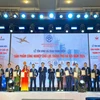The TPP Ministerial Meeting is taking place in Singapore from February 22 to 25 with participation of ministers from 12 TPP countries.
Ministers from the 12 Asia-Pacific countries, namely Australia, Brunei, Canada, Chile, Japan, Malaysia, Mexico, New Zealand, Peru, Singapore, the United States and Vietnam have gathered here for the meeting.
As scheduled, Vietnam’s Minister of Commerce and Industry Vu Huy Hoang will attend all sessions of the ministerial meeting. He will also have bilateral working sessions with other negotiation delegations during February 22-25.
According to some delegates, this time’s TPP Ministerial Meeting will continue discussing issues still at odds among negotiation delegations, including investment, financial services, State-owned enterprises, E-commerce, customs, intellectual property rights, labour, environment, agriculture and textiles.
Before the opening of the meeting, Singapore’s Prime Minister Lee Hsien Loong said in an interview with Chinese media group Caixin that negotiators “are very close to completing it” and that all the countries “are trying very hard” and “ought to be able to close this year”.
New Zealand’s Trade Minister Tim Groser said, in a statement on February 19 before leaving for the negotiations, that “the key objective of this upcoming meeting is to focus on resolving all outstanding issues with the aim of substantively completing a comprehensive and balanced, regional agreement”.
In February 19 broadcast discussion on New Zealand’s commitment to the regional economic integration and context for the TPP negotiations, Prime Minister John Key said that despite the controversial chapters in the TPP, including intellectual property and agricultural issues, “We remain confident that TPP can be concluded”.
He also said “It’s ambitious for the 12 countries. Countries like Japan who has historically set outside of significant free trade agreements so this would be a big step for them. The United States, I think, has a variety of reasons why it’s very interested in seeing a successful outcome for TPP but nevertheless they still have to get it through their Congress and Senate.”
Japan and the United States are the biggest economies in the grouping but are seeking agreement on their key bilateral issues – cars for the US and farm produce such as rice, beef, pork and diary for Japan .
Many observers said that they expected an in-principle deal to be unveiled during US President Barack Obama’s visit to Asia in April. But even if negotiators reach a draft agreement, passage of the TPP for many countries could drag on for more than a year.
However, experts all argued that there are economic benefits for all the participants, which now have a total population of more than 792 million and account for nearly 40 percent of global GDP and about one-third of all world trade.-VNA
Ministers from the 12 Asia-Pacific countries, namely Australia, Brunei, Canada, Chile, Japan, Malaysia, Mexico, New Zealand, Peru, Singapore, the United States and Vietnam have gathered here for the meeting.
As scheduled, Vietnam’s Minister of Commerce and Industry Vu Huy Hoang will attend all sessions of the ministerial meeting. He will also have bilateral working sessions with other negotiation delegations during February 22-25.
According to some delegates, this time’s TPP Ministerial Meeting will continue discussing issues still at odds among negotiation delegations, including investment, financial services, State-owned enterprises, E-commerce, customs, intellectual property rights, labour, environment, agriculture and textiles.
Before the opening of the meeting, Singapore’s Prime Minister Lee Hsien Loong said in an interview with Chinese media group Caixin that negotiators “are very close to completing it” and that all the countries “are trying very hard” and “ought to be able to close this year”.
New Zealand’s Trade Minister Tim Groser said, in a statement on February 19 before leaving for the negotiations, that “the key objective of this upcoming meeting is to focus on resolving all outstanding issues with the aim of substantively completing a comprehensive and balanced, regional agreement”.
In February 19 broadcast discussion on New Zealand’s commitment to the regional economic integration and context for the TPP negotiations, Prime Minister John Key said that despite the controversial chapters in the TPP, including intellectual property and agricultural issues, “We remain confident that TPP can be concluded”.
He also said “It’s ambitious for the 12 countries. Countries like Japan who has historically set outside of significant free trade agreements so this would be a big step for them. The United States, I think, has a variety of reasons why it’s very interested in seeing a successful outcome for TPP but nevertheless they still have to get it through their Congress and Senate.”
Japan and the United States are the biggest economies in the grouping but are seeking agreement on their key bilateral issues – cars for the US and farm produce such as rice, beef, pork and diary for Japan .
Many observers said that they expected an in-principle deal to be unveiled during US President Barack Obama’s visit to Asia in April. But even if negotiators reach a draft agreement, passage of the TPP for many countries could drag on for more than a year.
However, experts all argued that there are economic benefits for all the participants, which now have a total population of more than 792 million and account for nearly 40 percent of global GDP and about one-third of all world trade.-VNA



















